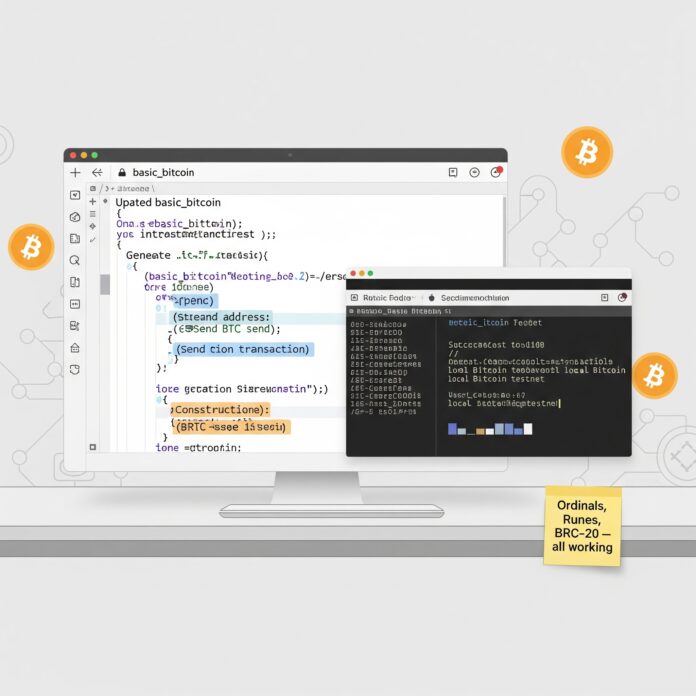Bitcoin DeFi is steadily moving into a more developer-friendly space, and the latest updates to the basic_bitcoin example mark another step forward. With contributions from Kristofer Lund and support from the Internet Computer ecosystem, developers now have a cleaner, clearer, and more capable set of tools for building on Bitcoin—without fighting the protocol every step of the way.
The updates revolve around making it easier for developers to interact with Bitcoin as they build DeFi applications on the Internet Computer. This includes enhanced examples covering Ordinals, BRC-20 tokens, and Runes—all of which open up new ways to create and manage digital assets directly on Bitcoin. It’s not about changing Bitcoin’s base layer—it’s about giving people more ways to work with it through scalable and secure infrastructure.
These examples serve a very practical purpose. For developers trying to onboard into Bitcoin-based DeFi, the landscape can be technical and slow-moving. The Internet Computer changes that by functioning as a sidechain or Layer 2 solution that’s deeply integrated with Bitcoin, offering programmable smart contracts, fast execution, and full interoperability with the Bitcoin network.
At the heart of this is a combination of technical features that other platforms can’t easily offer. The Internet Computer uses threshold ECDSA and Schnorr signatures, which let smart contracts on ICP manage Bitcoin keys securely without exposing private data. It also supports HTTPS outcalls and secure randomness, making it easier to interact with the wider internet or generate unique identifiers for digital assets. These capabilities are what allow developers to build projects like Odin.fun, Liquidium, Omnity, and Liquity—applications that are genuinely cross-chain and tailored to Bitcoin users.
To make this more accessible, the Bitcoin developer documentation has been thoroughly updated. These docs walk users through every part of the setup—from installing tooling like Rust, dfx, and bitcoind, to launching a local Bitcoin testnet, configuring the Internet Computer SDK, and debugging common problems. It’s the kind of step-by-step guidance that used to be scarce in Bitcoin development, and it aims to remove a lot of the friction that kept people away.
A large part of the work also involved refining the basic_bitcoin code example. This wasn’t just about adding features—it was about cleaning up the code, making it easier to understand, and adding inline documentation so that even less experienced developers could follow along. The improved example now handles both legacy and SegWit address generation, supports key management using threshold signatures, and walks through UTXO discovery, transaction signing, and dynamic fee calculations.
The protocol examples for Ordinals, BRC-20 tokens, and Runes are perhaps the most eye-catching additions. They each demonstrate how data and tokens can be inscribed, transferred, and managed on Bitcoin in slightly different ways.
Ordinals, for instance, allow data like text or images to be embedded directly onto satoshis. Each piece of content is inscribed using a two-part transaction process—first committing the data, then revealing it. The result is a permanent, traceable artefact stored immutably on the Bitcoin blockchain. This opens up creative and archival use cases, from art to identity proofs, all built directly into the ledger.
Runes, on the other hand, focus on creating fungible tokens. These are embedded into Bitcoin transactions using OP_RETURN and special markers. Unlike Ordinals, which are non-fungible by nature, Runes are created in a single transaction and can be transferred or minted much like any other token. The example provided shows how to generate, track, and interact with Runes without needing additional layers or third-party tooling.
Then there’s BRC-20—effectively a blend of both Ordinals and Runes. Built on top of the Ordinals protocol, BRC-20 tokens use structured JSON payloads that define standard operations like minting, transferring, or deploying new tokens. The updated example shows how to follow this inscription format properly and manage these tokens in a decentralised, verifiable way.
Each of these examples works with the Internet Computer in the loop, meaning transactions and interactions are managed securely and efficiently without needing to spin up traditional server infrastructure. It also means developers can write logic for Bitcoin transactions in Motoko or Rust and trust that the system will handle signing, broadcasting, and validation—using native Bitcoin integration provided by the Internet Computer.
On the development environment side, a lot of care went into making sure the tooling is current. Instructions on how to launch a Bitcoin testnet locally, how to generate and monitor addresses, how to submit and trace transactions—all of it is geared towards making developers feel confident about building with Bitcoin. There’s also guidance on using regtest mode for testing, which makes it possible to run full experiments without needing to interact with the live Bitcoin network or spend real BTC.
This combination of improved code, detailed documentation, and feature-rich examples lowers the barrier for anyone who wants to build something serious on Bitcoin. And with ICP acting as the backbone for execution and scaling, those applications can go far beyond what traditional Bitcoin scripting allows.
It’s also a signal to developers that the Internet Computer isn’t trying to replace Bitcoin—it’s trying to support it. By giving Bitcoin programmable functionality and acting as a secure execution environment, ICP makes it possible to keep the robustness of Bitcoin’s base layer while extending its use cases. That includes things like automated payments, NFT minting, digital identity, and even decentralised exchanges—all with Bitcoin as the underlying currency and ICP as the computation layer.
As more projects explore Bitcoin DeFi, tools like these are likely to become essential. It’s no longer just about proving that something can be done—it’s about giving people everything they need to actually do it. The updated basic_bitcoin example, paired with the Ordinals, Runes, and BRC-20 demos, shows that the Internet Computer is positioning itself as the go-to place for developers who want to innovate with Bitcoin without dealing with its traditional development headaches.
The work from contributors like Kristofer Lund has helped turn abstract technical potential into something that feels practical. And the focus isn’t on flashy marketing—it’s on improving the code, refining the experience, and letting developers create without guesswork. It’s exactly the kind of quiet infrastructure work that ends up changing what people build—and how quickly they build it.


